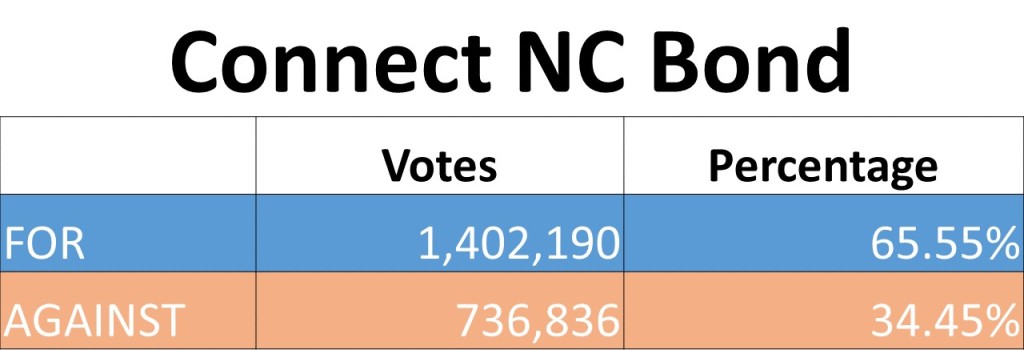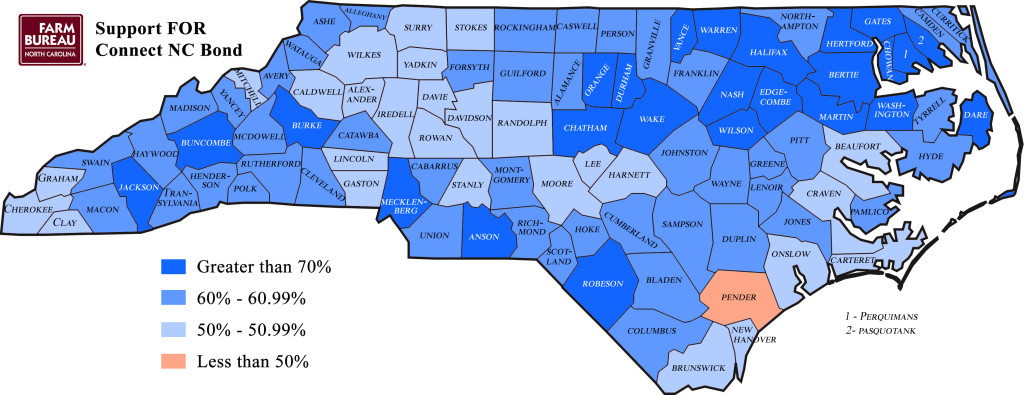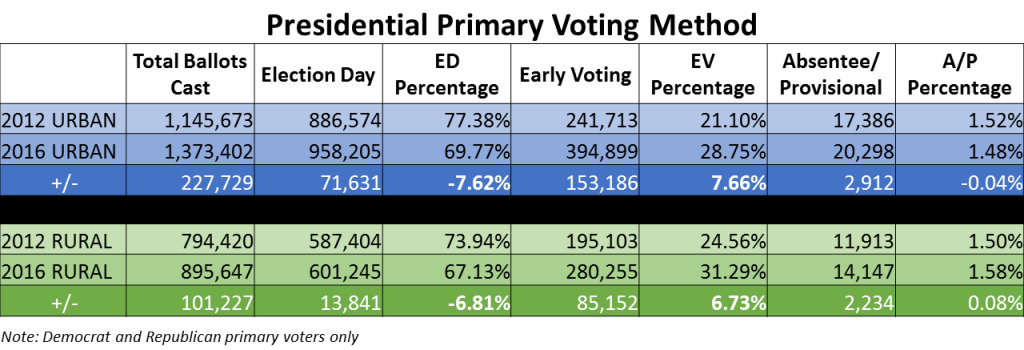Unlike the NCAA basketball tournament, the first round of North Carolina elections—last week’s primary—didn’t result in big upsets or surprises. The council of state races held as projected and, for the most part, incumbents in the state house and senate will be moving on to their general elections or returning to Raleigh for the 2017 long session.
Today, instead of analyzing individual races across the state, we will focus on the Farm Bureau-supported Connect NC Bond results and discuss a few voting trends that continue to emerge in urban and rural areas. (If you’re interested in learning about those other races, we highly recommended you read the NC Free Enterprise Foundation’s post-primary briefing.)
First things first, THE CONNECT NC BOND PASSED!
North Carolina overwhelmingly supported the $2 billion bond package, which won nearly two-thirds of the vote.
Second and as Farm Bureau was anticipating, urban and rural communities stood together to pass this vital investment  in the future of NC. Notably, more than half a million rural voters voted in favor of the bond.
in the future of NC. Notably, more than half a million rural voters voted in favor of the bond.
Third and final point about the bond: the measure ‘passed’ in 99 counties. The map below shows support for the Connect NC Bond when sorted by approval percentage and tiered. As you can see, the Connect NC Bond garnered statewide approval and demonstrated value in both urban and rural counties. Thank you NC voters!

What other voting trends were spotted?
1. NC’s Urban/Rural composition is rapidly CHANGING! A few weeks ago we posted a map with turnout statistics from the 2012 Presidential primary. That year, voter turnout in urban counties came in at 34.37% while turnout in rural counties was 35.84%.  This time around, however, voter turnout in urban counties rose to 35.60% while voter turnout in rural counties dropped to 34.98%. This could be the result of a variety of factors, including presidential campaign spending, voter enthusiasm, voter education efforts, or population increases/decreases. But one trend hitting North Carolina in the past decade or so has been the changing demographic profile of the state’s voters fueled by the growing concentration of voters in urban areas. NC Free Enterprise Foundation Executive Director Joe Stewart explains:
This time around, however, voter turnout in urban counties rose to 35.60% while voter turnout in rural counties dropped to 34.98%. This could be the result of a variety of factors, including presidential campaign spending, voter enthusiasm, voter education efforts, or population increases/decreases. But one trend hitting North Carolina in the past decade or so has been the changing demographic profile of the state’s voters fueled by the growing concentration of voters in urban areas. NC Free Enterprise Foundation Executive Director Joe Stewart explains:
Nearly half of all population growth in North Carolina since 2010 has been in just Mecklenburg and Wake counties—now over 20% of all NC voters live just in those two counties, and 50% of all voters live in the largest 13 counties. Half of the state’s current population is originally from some other place, and large numbers of those voting in North Carolina elections have lived here less than ten years.
There’s a different political orientation among recently arrived voters, as many tend to support candidates they like given particular issues of concern to them during that particular election, irrespective of partisan affiliation. And it’s a more racial and ethnically diverse population, with higher concentrations of Millennials and Generation X voters.
2. Early Voting is picking up steam with each election cycle. We also looked at differences in turnout and voting method for urban and rural voters. The next table shows these statistics along with the total number of ballots cast in urban and rural counties.

This chart shows North Carolina voters are changing the way they vote in big numbers. As you can see in the rows labeled +/-, 2016 Primary Election Day voting among urban and rural voters dropped about 7% when compared to the 2012 Primary Election, while Early Voting increased by about 7%. This shows a pretty significant shift away from Election Day voting in favor of Early Voting.
To take this one more step, we also looked at voting method in the 2012 General Election. What we found is that nearly 60% of votes for president were cast during Early Voting—compared to only 22.52% of votes cast during Early Voting in the 2012 Primary—meaning that Early Voting is even more popular among General Election voters. Coupled with the growth in Early Voting among Primary Election voters and the likelihood of high voter enthusiasm for the presidential election this fall, we could see nearly two-thirds of votes cast before Election Day this year.
Why are these trends important? First of all, changes in voter demographics and behavior will affect how candidates run their campaigns. Candidates will need to make an impression with voters earlier, and using new messaging and media. “North Carolina’s new generation voters get their election information more from internet and social media sources than traditional outlets such as newspapers, TV and political parties,” said Stewart.
Second, trends in voter demographics and behavior will also affect how elected officials discuss public policy. Again, Joe Stewart:
The continued urbanization of our state will result in a far greater consolidation of political power in the metro areas, with more legislative districts located in and around cities and fewer in the rural parts of the state. Public policy discussion and debate will be conducted in a legislature where a majority of members represent districts economically linked to urban hubs and by state officials who can win election only by doing well in the I-85 corridor between Charlotte and Raleigh.
Finally, and something folks in agriculture must watch closely, Stewart noted that “there is not a historic sense of the role agriculture has played in North Carolina’s economy [among newly arrived and new generation voters].”
In a nutshell, North Carolina is changing in many ways, including its demography and voting methods. These changes will be interesting to follow, and both candidates and voters need to understand how they will affect the political landscape in the state.
